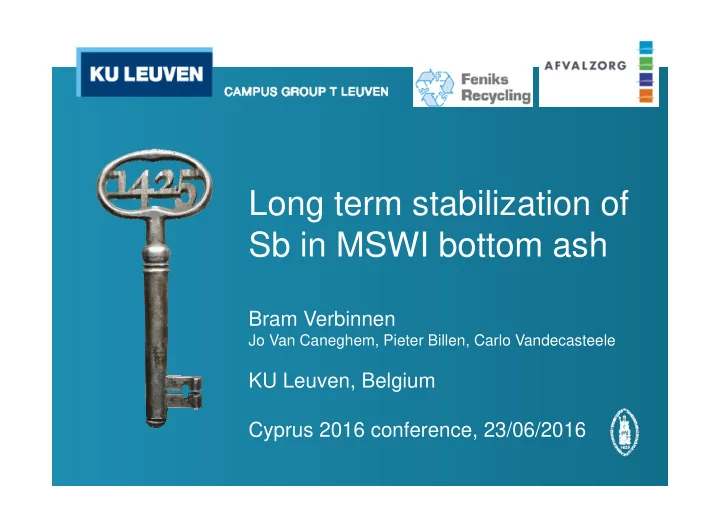

Long term stabilization of Sb in MSWI bottom ash Bram Verbinnen Jo Van Caneghem, Pieter Billen, Carlo Vandecasteele KU Leuven, Belgium Cyprus 2016 conference, 23/06/2016
MSWI Bottom Ash 2
MSWI Bottom Ash • Each application: specific chemical barrier • Most barriers can be overcome! • Some problems remain, or more strict legislation • Netherlands: Green Deal By 2017: 50% of BA in applications without protective measures o By 2020: No more use in applications with protective measures o Enhanced recovery of NF metals o o Most problematic: leaching of Sb 3
Sb leaching • Sb leaching known to be governed by: o Formation of calcium antimonates (romeites) 1 o Adsorption to iron (hydr)oxides o Formation of iron antimonate (tripuhyite, FeSbO 4 ) 2 o (Incorporation in ettringite) o All pH dependent! 4 1: Cornelis et al..: Antimony leaching from MSWI bottom ash: Modelling of the effect of pH and carbonation. Waste Management 32, 278-286 (2012) 2: Okkenhaug et al..: Treatment of air pollution control residues with iron rich waste sulfuric acid: Does it work for antimony (Sb)? Journal of Hazardous Materials 248, 159-166 (2013)
Reduce Sb leaching • Based on these mechanisms: addition of o Fe- and Ca- salts o Industrial waste streams containing Fe- and Ca-salts • Experimental o Short term leaching behavior • Lab batch tests o Middle-long term leaching behavior • Outdoor field tests o Long term leaching behavior • Lab carbonation tests 5
Short term leaching behavior • pH dependent leaching behavior • Addition of: Fe- and Ca-containing compounds Fe- and Ca-containing industrial residues (10%) 6
Short term leaching behavior • Additives: o Ca-compounds • CaO, CaCl 2 : formation and precipitation of romeites • CaCO 3 : less soluble, no precipitation o Fe-compounds • Formation of tripuhyite o Industrial residues • Formation of Ca-antimonates (A2, A3: soluble Ca-compounds) • No adsorption on iron oxides (A1: no soluble Ca-compounds, iron oxides) 7
Middle-long term leaching behavior • Outdoor field tests o Sb concentrations initially decreased • Lower than untreated BA & regulatory limit value o Increase slightly over time as pH decreases • Romeites become more soluble at lower pH values 8
Long term leaching behavior • Carbonation o BA: decreasing o Fe 2 (SO 4 ) 3 : initially lower, increasing 1,8 Sb Leaching concentration 1,6 1,4 pH sweep 1,2 -1 ) BA (mgkg DM 1 0,8 2.5% Fe2(SO4)3 0,6 Dutch limit value 0,4 0,2 0 4,0 6,0 8,0 10,0 12,0 14,0 Leachate pH
Long term leaching behavior • Carbonation o A2: initially lower, increasing, below limit value o A3: initially lower, increasing, around limit value 1,8 Sb Leaching concentration 1,6 pH sweep 1,4 1,2 BA -1 ) (mgkg DM 1 10% A2 0,8 10% A3 0,6 Dutch limit value 0,4 0,2 0 4,0 6,0 8,0 10,0 12,0 14,0 Leachate pH
Long term leaching behavior • Sb leaching from treated BA increasing after carbonation o Romeites more soluble at lower pH 1 • Sb leaching from untreated BA decreases after carbonation o Can not be explained by 4 mechanisms 11 1: Cornelis et al..: Antimony leaching from MSWI bottom ash: Modelling of the effect of pH and carbonation. Waste Management 32, 278-286 (2012)
Additional tests • Explain Sb leaching from untreated BA after carbonation • Leaching behavior similar to Cu leaching 1.8 10 1.6 pH dependent leaching pH dependent leaching After carbonation 1.4 After carbonation Sb leached (mg/kg) Cu leached (mg/kg) 1.2 Cu Sb 1.0 0.8 0.6 0.4 0.2 1 0.0 4 6 8 10 12 14 4 6 8 10 12 14 pH pH • Sb leaching also influenced by organic acids? o Sb known to form complexes with organic acids 3 o Heat treatment (400°C, 30 min) o Addition of activated carbon 12 3: Steely et al.: An investigation of inorganic antimony species and antimony associated with soil humic acid molar mass fractions in contaminated soils. Environmental Pollution 148, 590-598 (2007)
Additional tests Leaching behavior after heat treatment and AC addition 1.2 10 pH dependent Carbonation 1.0 Activated carbon Heating Cu leached (mg/kg) Sb leached (mg/kg) 0.8 1 0.6 Sb Cu pH dependent leaching 0.4 0.1 After carbonation Activated carbon Heating 0.2 0.0 0.01 4 6 8 10 12 14 4 6 8 10 12 14 pH pH • Behavior similar to Cu o AC addition: adsorption of complexes on AC o Heat treatment: decarboxylation of organic acids o Carbonation: adsorption of organo-metallic complexes 4 ? 13 4: Arickx et al..: Effect of carbonation on the leaching of organic carbon and of copper from MSWI bottom ash. Waste Management 30, 1296-1302 (2010)
Conclusions • Sb leaching from MSWI BA can be reduced by addition of chemical compounds and Ca- and Fe-containing industrial residues • Effect of addition endures in middle-long and long term leaching experiments • More insight is gained in mechanisms governing Sb leaching from MSWI BA: o Plausible that organic matter plays a role o Influence needs to be further investigated 14
Thank you! Bram.verbinnen@kuleuven.be
Recommend
More recommend